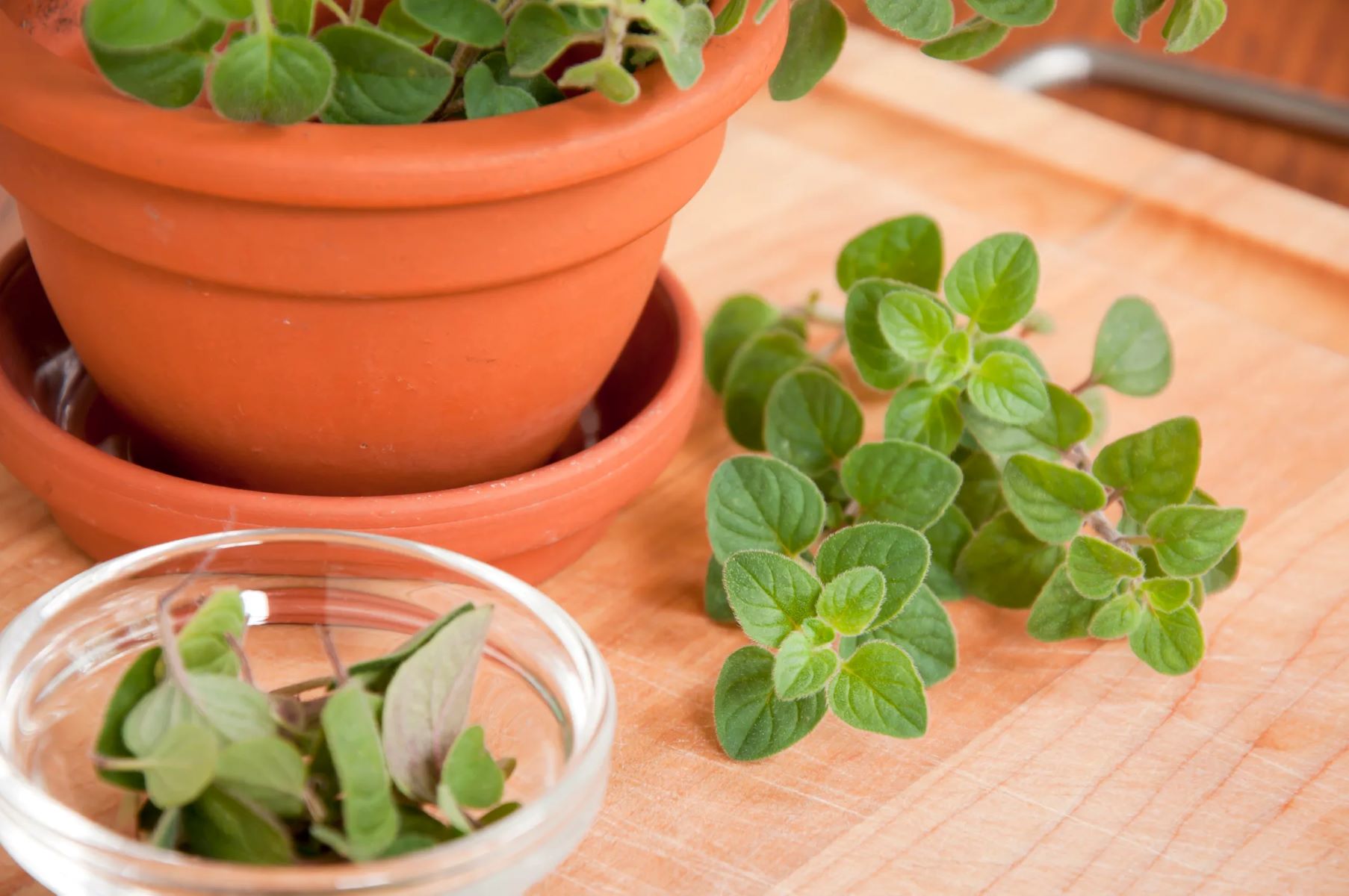Home>Food and Cooking>The Surprising Difference Between Italian And Greek Oregano Revealed!


Food and Cooking
The Surprising Difference Between Italian And Greek Oregano Revealed!
Published: January 21, 2024
Discover the unique flavors of Italian and Greek oregano and how they can elevate your cooking. Explore the surprising differences between these two varieties and enhance your culinary skills!
(Many of the links in this article redirect to a specific reviewed product. Your purchase of these products through affiliate links helps to generate commission for Regretless.com, at no extra cost. Learn more)
Table of Contents
Introduction
Oregano, a beloved herb in the culinary world, is renowned for its aromatic and flavorful presence in a wide array of dishes. While many may consider oregano to be a singular entity, there are distinct varieties that bring their own unique characteristics to the table. In this article, we will delve into the intriguing differences between Italian and Greek oregano, shedding light on their individual attributes, flavor profiles, culinary applications, and even their medicinal properties. By exploring the nuances of these two varieties, we aim to provide a comprehensive understanding of their distinct qualities, empowering readers to make informed choices when incorporating oregano into their culinary creations. So, let's embark on this flavorful journey and uncover the surprising disparities between Italian and Greek oregano!
What is Oregano?
Oregano, scientifically known as Origanum vulgare, is a perennial herb belonging to the mint family, Lamiaceae. This aromatic herb is native to the Mediterranean region and is revered for its robust flavor and enticing fragrance. Oregano is characterized by its small, oval-shaped leaves that grow in pairs along the stem, and depending on the variety, it can showcase different shades of green.
The herb's name is derived from the Greek words "oros" and "ganos," translating to "mountain" and "joy," respectively, which alludes to its natural habitat and the happiness it brings to culinary dishes. Oregano has been a staple in Mediterranean cuisine for centuries, adding depth and complexity to a myriad of dishes.
Apart from its culinary significance, oregano has also been utilized for its medicinal properties. It is rich in antioxidants, vitamins, and minerals, making it a valuable ingredient in traditional medicine. Oregano is celebrated for its anti-inflammatory, antimicrobial, and antiviral properties, contributing to its historical use in treating various ailments.
In essence, oregano is a versatile and flavorful herb that has made its mark in both the culinary and medicinal realms. Its distinct aroma and taste have solidified its place in global cuisine, while its health benefits continue to be explored and appreciated. As we explore the differences between Italian and Greek oregano, it's essential to first understand the fundamental nature of this cherished herb.
This section provides a foundational understanding of oregano, setting the stage for a deeper exploration into the unique characteristics of Italian and Greek varieties.
Italian Oregano
Italian oregano, scientifically classified as Origanum vulgare subsp. hirtum, is a variety revered for its robust flavor and aromatic presence. This particular subspecies of oregano is indigenous to the Mediterranean region, particularly Italy, where it thrives in the sun-drenched hillsides and coastal areas. Italian oregano is characterized by its vibrant green leaves and a pungent, slightly bitter taste, which sets it apart from other oregano varieties.
The flavor profile of Italian oregano is marked by its intense and earthy notes, with hints of citrus and a subtle peppery undertone. This distinctive flavor profile makes it a sought-after ingredient in Italian cuisine, where it is used to elevate the taste of various dishes, including pasta sauces, pizzas, and grilled meats. Italian oregano is often incorporated into marinades, imparting a rich and aromatic essence that enhances the overall depth of flavor in savory preparations.
In addition to its culinary prowess, Italian oregano is valued for its medicinal properties. It is known for its high concentration of essential oils, particularly carvacrol and thymol, which contribute to its antimicrobial and antioxidant attributes. These beneficial compounds make Italian oregano a valuable component in natural remedies, where it is utilized to alleviate respiratory issues, digestive discomfort, and even as a topical treatment for minor skin irritations.
When it comes to cultivation, Italian oregano thrives in well-drained soil and ample sunlight, reflecting its origins in the Mediterranean climate. This variety of oregano is known for its hardy nature, making it relatively low-maintenance and adaptable to various growing conditions. Whether cultivated in home gardens or commercial farms, Italian oregano flourishes with proper care and attention, rewarding growers with an abundant yield of flavorful leaves.
Italian oregano stands as a testament to the rich culinary and horticultural heritage of the Mediterranean, embodying the essence of Italian cuisine and traditional herbal remedies. Its bold flavor, coupled with its versatile applications, cements its status as a prized herb in the culinary world. As we immerse ourselves in the world of Italian oregano, it becomes evident that its distinct qualities contribute to the vibrant tapestry of flavors that define Mediterranean-inspired dishes.
Greek Oregano
Greek oregano, scientifically known as Origanum vulgare subsp. hirtum, is a revered variety of oregano that exudes a distinct and captivating essence. Originating from the Mediterranean region, particularly Greece, this subspecies of oregano boasts a rich history deeply intertwined with the culinary traditions of the region. Its robust flavor and aromatic allure have solidified its status as a prized herb in both traditional and contemporary culinary practices.
The flavor profile of Greek oregano is characterized by its harmonious blend of pungency and warmth, with subtle hints of mint and a delicate floral undertone. This unique amalgamation of flavors sets Greek oregano apart, endowing dishes with a nuanced and savory dimension. The herb's leaves, showcasing a vibrant green hue, possess a captivating aroma that evokes images of sun-drenched Mediterranean landscapes, adding a touch of authenticity to every culinary creation.
In Greek cuisine, oregano holds a revered position, serving as a quintessential ingredient in a myriad of dishes. From classic Greek salads and savory meat preparations to flavorful marinades and aromatic soups, Greek oregano imparts a depth of flavor that is synonymous with the culinary identity of the region. Its versatile nature allows it to seamlessly complement a diverse range of ingredients, elevating the overall taste profile of dishes and infusing them with a touch of Mediterranean charm.
Beyond its culinary prowess, Greek oregano is esteemed for its medicinal properties, echoing the rich tradition of herbal remedies prevalent in Mediterranean cultures. The herb is renowned for its high concentration of essential oils, including carvacrol and thymol, which contribute to its antimicrobial, antioxidant, and anti-inflammatory attributes. These beneficial compounds have been harnessed for centuries to address various health concerns, ranging from digestive discomfort to respiratory issues, underscoring the holistic significance of Greek oregano.
When it comes to cultivation, Greek oregano thrives in well-drained soil and abundant sunlight, mirroring the environmental conditions of its native habitat. Its resilience and adaptability make it well-suited for home gardens and commercial cultivation, rewarding growers with an abundant yield of flavorful leaves that encapsulate the essence of the Mediterranean terroir.
In essence, Greek oregano stands as a testament to the rich culinary and herbal heritage of the Mediterranean, embodying the essence of Greek cuisine and traditional medicinal practices. Its captivating flavor, coupled with its versatile applications, cements its status as a cherished herb that continues to captivate palates around the world. As we immerse ourselves in the world of Greek oregano, it becomes evident that its distinct qualities contribute to the vibrant tapestry of flavors that define Mediterranean-inspired dishes.
Flavor Profile
Italian oregano, scientifically classified as Origanum vulgare subsp. hirtum, is renowned for its robust flavor and aromatic essence. The flavor profile of Italian oregano is marked by its intense and earthy notes, with hints of citrus and a subtle peppery undertone. This distinctive combination of flavors sets Italian oregano apart, endowing dishes with a nuanced and savory dimension. The vibrant green leaves of Italian oregano exude a captivating aroma that evokes images of sun-drenched Mediterranean landscapes, adding a touch of authenticity to every culinary creation.
On the other hand, Greek oregano, also scientifically known as Origanum vulgare subsp. hirtum, boasts a flavor profile characterized by its harmonious blend of pungency and warmth, with subtle hints of mint and a delicate floral undertone. This unique amalgamation of flavors sets Greek oregano apart, infusing dishes with a captivating and savory dimension that is synonymous with the culinary identity of the region. The herb's leaves, showcasing a vibrant green hue, possess a captivating aroma that evokes images of sun-drenched Mediterranean landscapes, adding a touch of authenticity to every culinary creation.
In essence, both Italian and Greek oregano varieties offer distinct flavor profiles that contribute to the vibrant tapestry of flavors in Mediterranean-inspired dishes. While Italian oregano exhibits intense earthy notes with citrus and peppery undertones, Greek oregano presents a harmonious blend of pungency and warmth with subtle hints of mint and delicate floral undertones. These unique flavor profiles reflect the diverse culinary traditions of the Mediterranean region, enriching dishes with depth and authenticity.
Culinary Uses
Italian oregano, with its robust and intense flavor profile, is a staple ingredient in Italian cuisine. Its vibrant, citrusy notes and subtle peppery undertones make it a versatile addition to a myriad of dishes. Italian oregano shines in pasta sauces, where it infuses the rich, savory flavors with a tantalizing aroma. It also elevates the taste of pizzas, adding depth and authenticity to every slice. Grilled meats and marinades benefit from the bold presence of Italian oregano, imparting a robust and aromatic essence that enhances the overall flavor profile.
In Greek cuisine, Greek oregano holds a revered position, serving as a quintessential ingredient in a myriad of dishes. From classic Greek salads and savory meat preparations to flavorful marinades and aromatic soups, Greek oregano imparts a depth of flavor that is synonymous with the culinary identity of the region. Its versatile nature allows it to seamlessly complement a diverse range of ingredients, elevating the overall taste profile of dishes and infusing them with a touch of Mediterranean charm.
Both Italian and Greek oregano varieties are utilized in a wide array of culinary creations, including roasted vegetables, grilled seafood, and hearty stews. Their aromatic presence adds a layer of complexity to dressings and vinaigrettes, enhancing the overall dining experience. Whether sprinkled over freshly baked bread or incorporated into herb-infused oils, the distinct flavors of Italian and Greek oregano elevate dishes, imparting a touch of authenticity and a burst of Mediterranean-inspired essence.
In essence, Italian and Greek oregano play pivotal roles in defining the flavor profiles of Mediterranean-inspired dishes, offering a nuanced and savory dimension that captures the essence of the region's culinary heritage. Their versatility and aromatic allure make them indispensable in the kitchen, allowing chefs and home cooks to infuse their creations with the vibrant flavors of the Mediterranean.
Medicinal Properties
Italian and Greek oregano are not only esteemed for their culinary contributions but also for their remarkable medicinal properties. Both varieties contain high levels of essential oils, particularly carvacrol and thymol, which are known for their potent antimicrobial, antioxidant, and anti-inflammatory effects.
The essential oils present in Italian oregano contribute to its medicinal prowess. Carvacrol, a major component of Italian oregano oil, has been studied for its antibacterial and antifungal properties. It exhibits potential in combating various strains of bacteria, making it a valuable natural remedy for addressing bacterial infections. Additionally, the antioxidant properties of Italian oregano contribute to its ability to neutralize free radicals in the body, potentially reducing oxidative stress and supporting overall well-being.
Similarly, Greek oregano boasts a rich concentration of essential oils, particularly thymol, which has been recognized for its antimicrobial and antifungal properties. These properties make Greek oregano a valuable component in natural remedies aimed at addressing microbial imbalances and promoting overall health. Furthermore, the antioxidant attributes of Greek oregano contribute to its potential in combating oxidative damage and supporting the body's defense mechanisms.
Both Italian and Greek oregano have been historically utilized in traditional medicine to address various health concerns. From digestive discomfort to respiratory issues, oregano has been harnessed for its holistic benefits. It has been used in herbal infusions, tinctures, and topical applications to alleviate symptoms and promote well-being.
In summary, the medicinal properties of Italian and Greek oregano underscore their holistic significance beyond the realm of culinary applications. Their high concentration of essential oils, coupled with their antimicrobial, antioxidant, and anti-inflammatory attributes, positions them as valuable allies in promoting overall health and well-being. Whether incorporated into herbal preparations or consumed as part of a balanced diet, Italian and Greek oregano offer a natural approach to supporting health and vitality.
Growing Conditions
Italian and Greek oregano thrive in specific growing conditions that mirror their native Mediterranean habitats. Understanding these optimal environments is crucial for cultivating robust and flavorsome oregano plants.
Italian Oregano
Italian oregano, with its origins in the sun-drenched hillsides and coastal areas of the Mediterranean, is well-adapted to thrive in warm, arid climates. When cultivating Italian oregano, it is essential to provide well-drained soil and ample sunlight. The herb flourishes in soil with good drainage, preventing waterlogging that can impede its growth. Additionally, Italian oregano benefits from a minimum of six to eight hours of direct sunlight, simulating the conditions of its native habitat. In regions with cooler climates, Italian oregano can be grown in containers that can be moved to sunlit areas or indoors during colder seasons. This adaptability makes it a viable option for home gardens and urban settings.
Greek Oregano
Similar to Italian oregano, Greek oregano thrives in environments that mimic the Mediterranean climate. It requires well-drained soil and abundant sunlight to flourish. The soil should ideally have a slightly alkaline pH, ranging from 7.0 to 8.0, mirroring the conditions of its native habitat. Greek oregano also benefits from a warm and sunny environment, making it well-suited for outdoor cultivation in regions with ample sunlight. In areas with cooler climates, Greek oregano can be cultivated in containers and positioned in sunlit areas or moved indoors during colder periods. This adaptability allows for the successful cultivation of Greek oregano in a variety of settings, from traditional gardens to urban balconies.
By providing the appropriate growing conditions, enthusiasts can cultivate thriving Italian and Greek oregano plants, ensuring a bountiful harvest of aromatic and flavorful leaves. Whether grown in traditional outdoor gardens or in containers, these varieties of oregano reward growers with an abundant yield, allowing them to savor the authentic flavors of the Mediterranean in their culinary creations.
Conclusion
In conclusion, the exploration of Italian and Greek oregano has unveiled a fascinating tapestry of flavors, aromas, and cultural significance deeply rooted in the Mediterranean heritage. The distinct qualities of Italian oregano, with its robust and intense flavor profile, and Greek oregano, characterized by its harmonious blend of pungency and warmth, underscore the rich diversity within the world of oregano. These variations in flavor and aroma offer culinary enthusiasts an array of options to elevate their dishes, infusing them with the authentic essence of the Mediterranean.
The culinary applications of Italian and Greek oregano extend beyond geographical boundaries, enriching a myriad of dishes with their vibrant flavors. From classic Italian pasta sauces and pizzas to traditional Greek salads and savory meat preparations, the versatile nature of these oregano varieties ensures their seamless integration into global cuisine. Their aromatic allure and nuanced taste profiles contribute to the creation of memorable dining experiences, capturing the essence of Mediterranean-inspired dishes.
Furthermore, the medicinal properties of Italian and Greek oregano, stemming from their high concentration of essential oils, including carvacrol and thymol, demonstrate their holistic significance. These beneficial compounds, with their antimicrobial, antioxidant, and anti-inflammatory attributes, position Italian and Greek oregano as valuable allies in promoting overall health and well-being. Whether incorporated into herbal remedies or consumed as part of a balanced diet, oregano offers a natural approach to supporting health and vitality.
The cultivation of Italian and Greek oregano, with their shared preference for well-drained soil and abundant sunlight, reflects their adaptation to the Mediterranean climate. Whether grown in traditional outdoor gardens or in containers, these oregano varieties reward enthusiasts with an abundant yield of flavorful leaves, allowing them to savor the authentic flavors of the Mediterranean in their culinary creations.
In essence, the surprising differences between Italian and Greek oregano underscore the depth of culinary and cultural diversity found within the Mediterranean region. Their individual characteristics, from flavor profiles to medicinal properties, contribute to the vibrant tapestry of flavors that define Mediterranean-inspired dishes. As culinary enthusiasts continue to explore the diverse nuances of Italian and Greek oregano, they embark on a flavorful journey that celebrates the rich heritage and timeless allure of these beloved herbs.













